Key takeaways:
- Artistic authenticity involves genuine self-expression and emotional connection, transcending trends and polished perfection.
- Music journalism plays a vital role in bridging artists and audiences, enhancing appreciation and accountability for authenticity in artistry.
- Evaluating authenticity in artists requires assessing the consistency of their message, vulnerability, and willingness to take risks.
- Embracing diverse artistic expressions enriches experiences and promotes an inclusive atmosphere, fostering deeper connections with music.
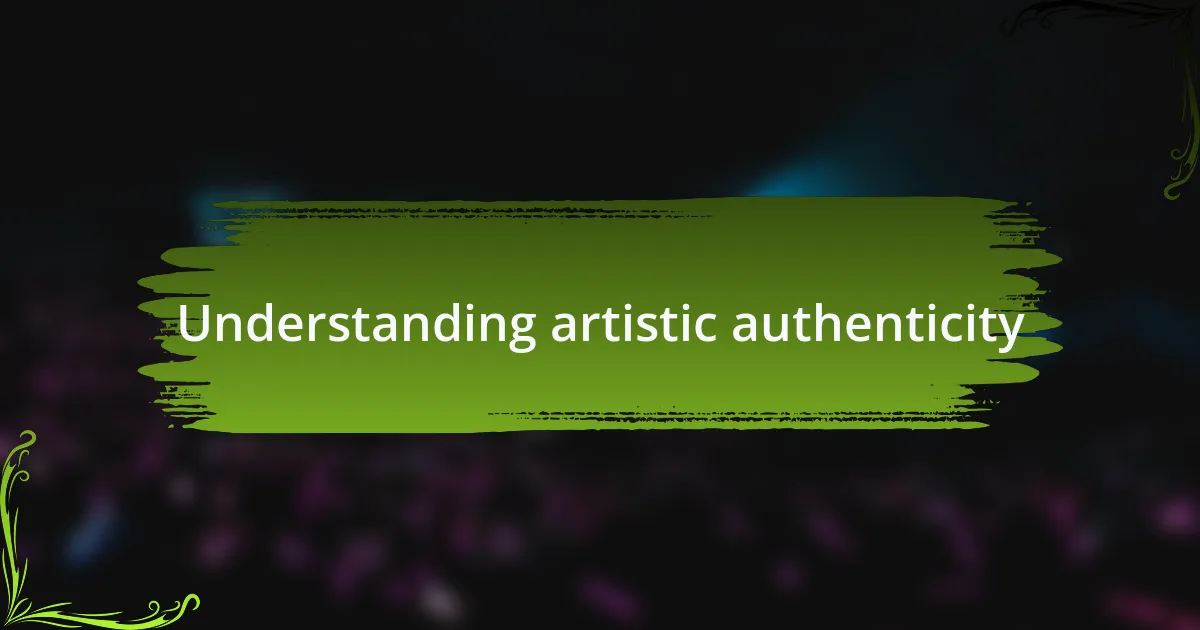
Understanding artistic authenticity
Artistic authenticity is often perceived as the genuine expression of an artist’s true self. I remember attending an intimate concert where the performer shared their struggles, and in that moment, I could feel their vulnerability. It struck me that authenticity isn’t just about what we create; it’s about how deeply we connect with those emotions and experiences.
Consider how easy it is to get lost in trends or societal expectations. Have you ever felt like an artist was simply mimicking others to gain popularity? I certainly have. It’s disheartening when music lacks that soul it once brimmed with, revealing a lack of true artistic integrity. Authenticity invites us to dig beneath the surface and reflect on the artist’s journey—where they’ve been and how that informs what they offer to the world.
Understanding artistic authenticity involves recognizing that it can’t be manufactured. It’s about embracing imperfections and the rawness of creation, akin to the first draft of a song filled with emotion but lacking polish. From my perspective, the true beauty of art lies in those spontaneous, unrefined moments; they often speak louder than the most perfected notes ever could.
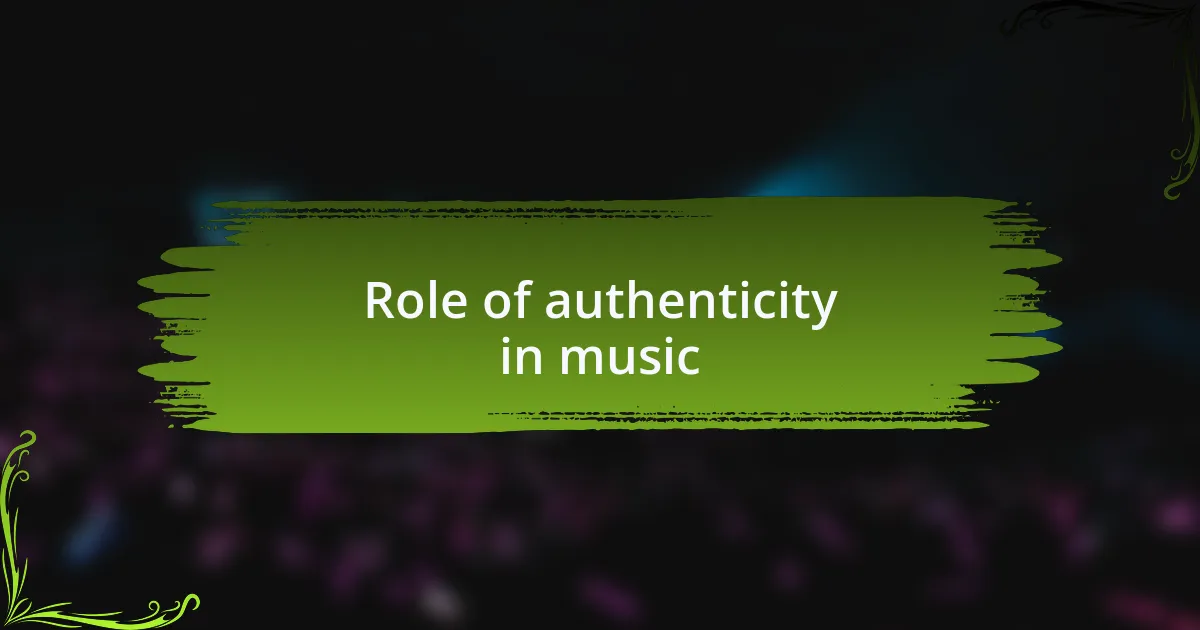
Role of authenticity in music
The role of authenticity in music goes beyond just the notes and lyrics; it’s an intimate reflection of the artist’s identity. I recall listening to a songwriter share their life story through their songs, each word resonating with truth and sincerity. That moment made me appreciate how authenticity shapes not just the music, but the entire listening experience, creating a bond that feels genuine and relatable.
Imagine attending a concert where every song feels choreographed and the artist seems distant. That lack of connection can leave you feeling empty, don’t you think? It’s in the unfiltered moments, the small slip-ups or heartfelt confessions, that we truly feel the weight of an artist’s message. The ability to be vulnerable transforms a performance into a shared journey, highlighting how authenticity can make or break the music.
When artists embrace their authenticity, they invite listeners into their world, fostering a deeper appreciation. I’ve often found that some of my favorite tracks stem from an artist’s bravest, most honest inspirations. Those moments remind us that music is a powerful tool for expression; it’s about being real in a world where everyone might be trying to sound perfect.
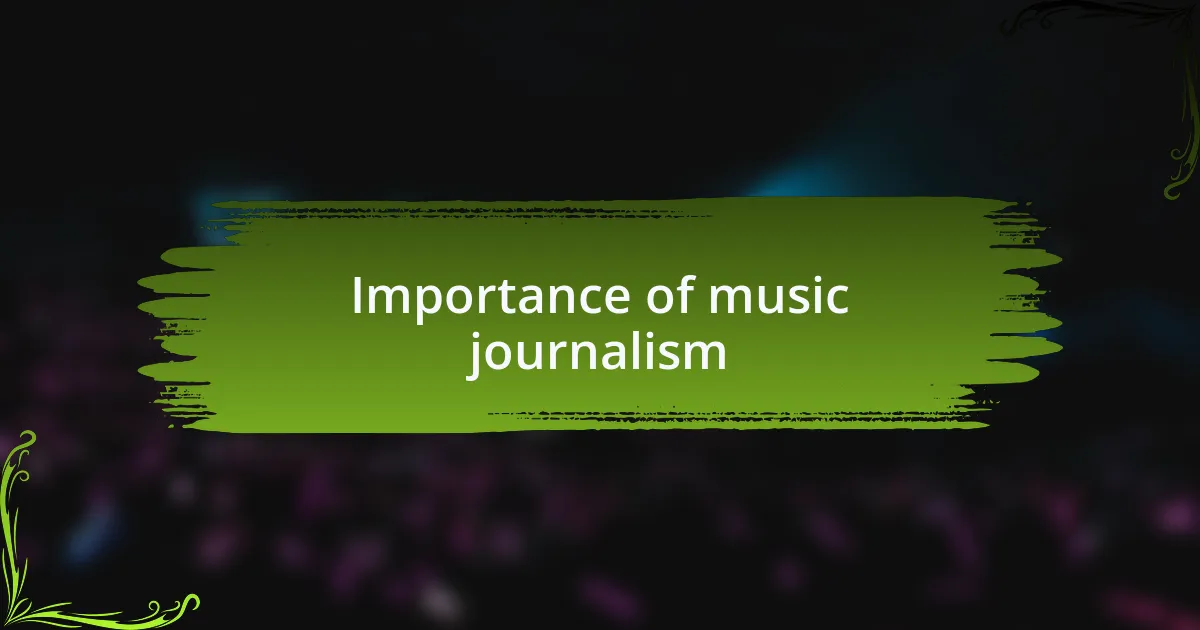
Importance of music journalism
In the realm of music journalism, the significance lies in its power to bring artists and their stories to life. I remember the first time I read a deeply insightful piece about an underground band. It illuminated their struggles and triumphs, making me feel like I was witnessing their journey firsthand. This kind of storytelling fosters a profound connection between readers and artists, enhancing our understanding of their music.
Music journalism plays a crucial role in shaping public perception. Have you ever found yourself drawn to a song because of a captivating review? I know I have. A well-crafted article can spark curiosity, turning a casual listener into a passionate fan. By dissecting the nuances of an artist’s work, journalists help us appreciate the artistry that might otherwise go unnoticed.
Moreover, the critical lens of music journalism can hold artists accountable, encouraging them to stay true to their vision. I often reflect on how certain reviews pushed me to explore new genres or challenge my musical tastes. This dynamic exchange not only enriches the listener’s experience but also fosters a culture where authenticity is celebrated and upheld, ensuring that music continues to resonate on a deeper level.
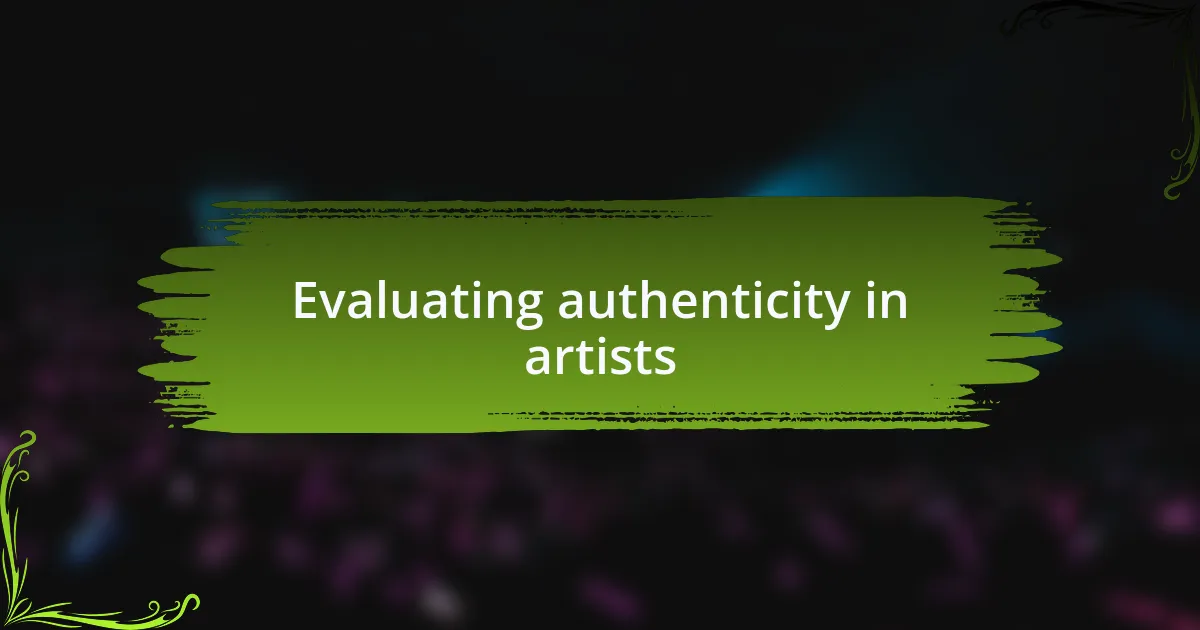
Evaluating authenticity in artists
When evaluating authenticity in artists, it’s essential to consider the consistency of their message and persona. I often find myself questioning whether an artist’s public image aligns with their music. For instance, there was this band I loved that seemed to shift their style dramatically. It left me wondering if they were chasing trends rather than expressing who they truly were.
Another factor is the vulnerability that artists display in their work. I remember listening to a singer-songwriter whose lyrics were painfully honest, reflecting personal experiences that resonated deeply with me. It felt refreshing, almost like a conversation with a friend, making me realize how authenticity can create genuine connections between the artist and the audience. Have you ever had a similar experience with a song that felt like a reflection of your own life? It’s in those moments that I think we see the true core of artistic authenticity.
Lastly, authenticity often reveals itself through an artist’s willingness to take risks and be misunderstood. I admire those musicians who push boundaries, even if their work isn’t immediately embraced. Their bravery inspires listeners to embrace their individuality too. It’s a reminder that real artistry thrives not just in acceptance, but in vulnerability and the courage to reveal oneself.
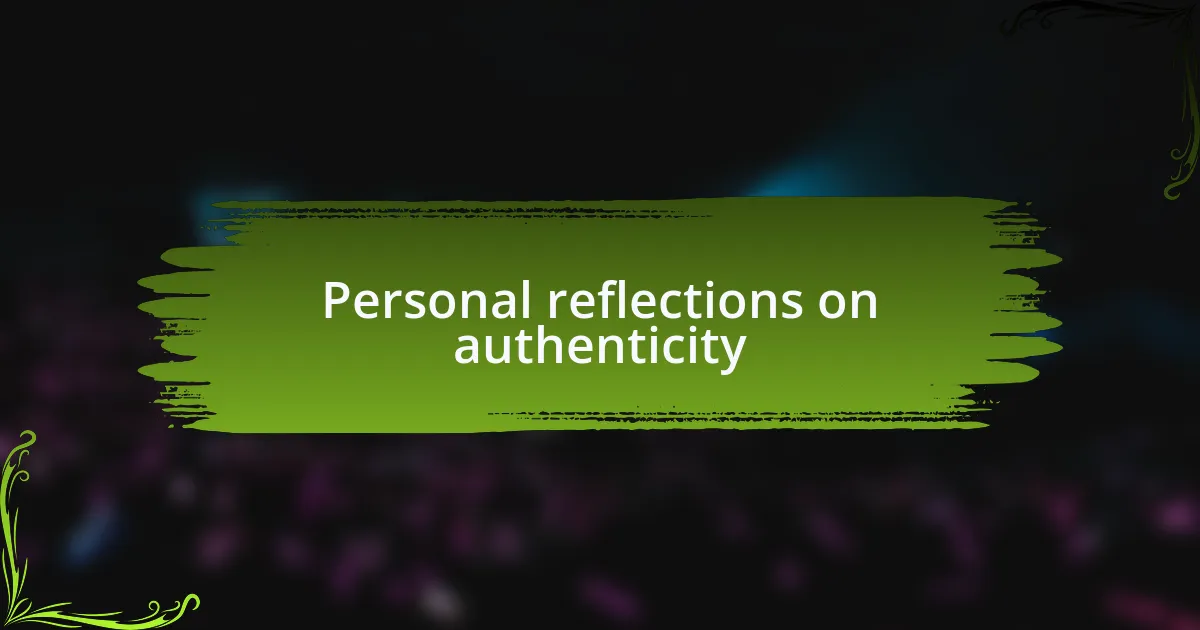
Personal reflections on authenticity
When I think about authenticity, I often reflect on my first encounter with an underground artist at a small venue. Their performance was raw and unpolished, but the emotion was palpable. It made me realize that authenticity isn’t about perfection; it’s about the truthfulness of the experience. Have you ever noticed how the most compelling performances can break down the walls between the artist and the audience?
There was another moment that struck me while attending a music festival. An artist took the stage, and instead of delivering a scripted set, they shared personal stories about the songs. This openness created an intimate atmosphere, one where everyone in the crowd felt connected. It dawned on me that true authenticity often comes from being relatable and real, rather than fitting into an expected mold.
I sometimes wonder if the pressure to maintain a certain image impacts artistic authenticity. As I’ve observed various artists navigating social media, it seems that some feel compelled to present a curated version of themselves. How does this impact their music? For many, it might dilute the essence of their artistry. Personally, I find it refreshing when artists choose to be themselves, flaws and all, shunning conformity in favor of genuine expression.
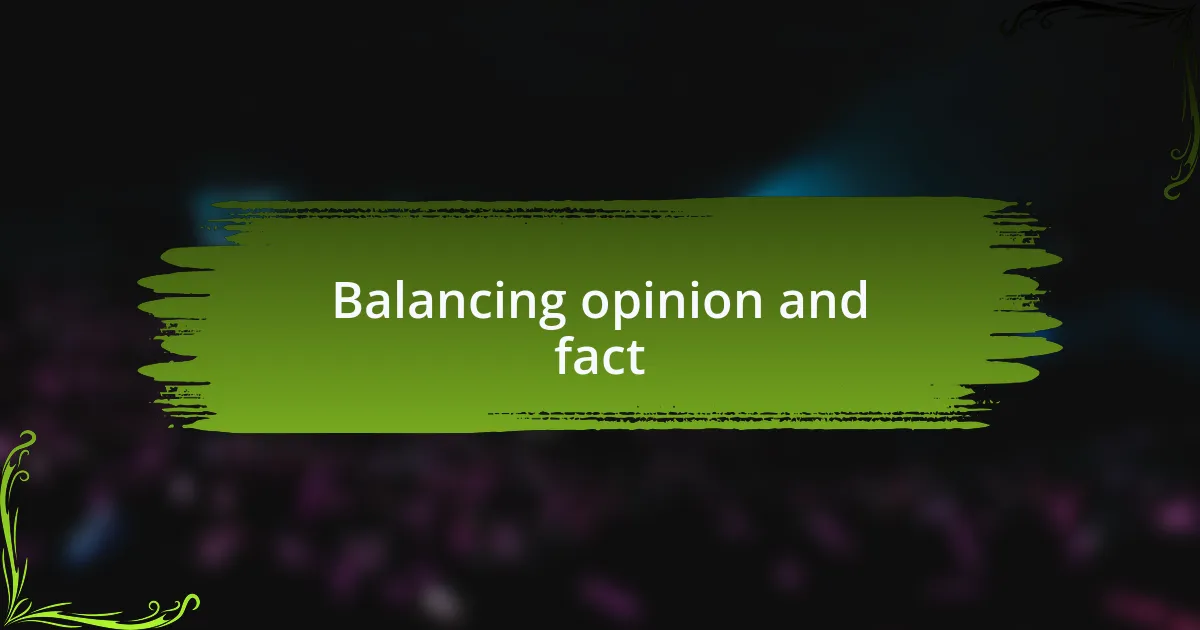
Balancing opinion and fact
When discussing artistic expression, I often grapple with the challenge of balancing my opinions with the hard facts of the music itself. I recall writing a review for a local band’s debut album; my personal take was that their sound was innovative, but the technical production left something to be desired. This realization forced me to navigate my admiration for their creativity while also acknowledging the realities of sound quality. Can we truly appreciate an artist’s vision if we overlook the aspects that might detract from it?
As I dive deeper into the world of music journalism, I’ve learned that bias can creep in, especially when I have a connection to the artists. I remember a time when I was far too lenient on a friend’s project because I wanted to support them. It didn’t occur to me until later that I had overlooked some critical feedback that could have helped them grow. This experience taught me the importance of maintaining a clear line between friendship and honest appraisal. How do we ensure our opinions don’t cloud our ability to critique effectively?
Ultimately, it’s crucial that the facts inform our opinions while our opinions add depth to the factual analysis. I often refer back to interviews with artists, which provide tremendous insights into their creative process, giving me more context to my reviews. This interplay between subjective feelings and objective data creates a richer dialogue that benefits both the reader and the artist. Isn’t it fascinating how a well-balanced piece can illuminate the nuances that may otherwise go unnoticed?
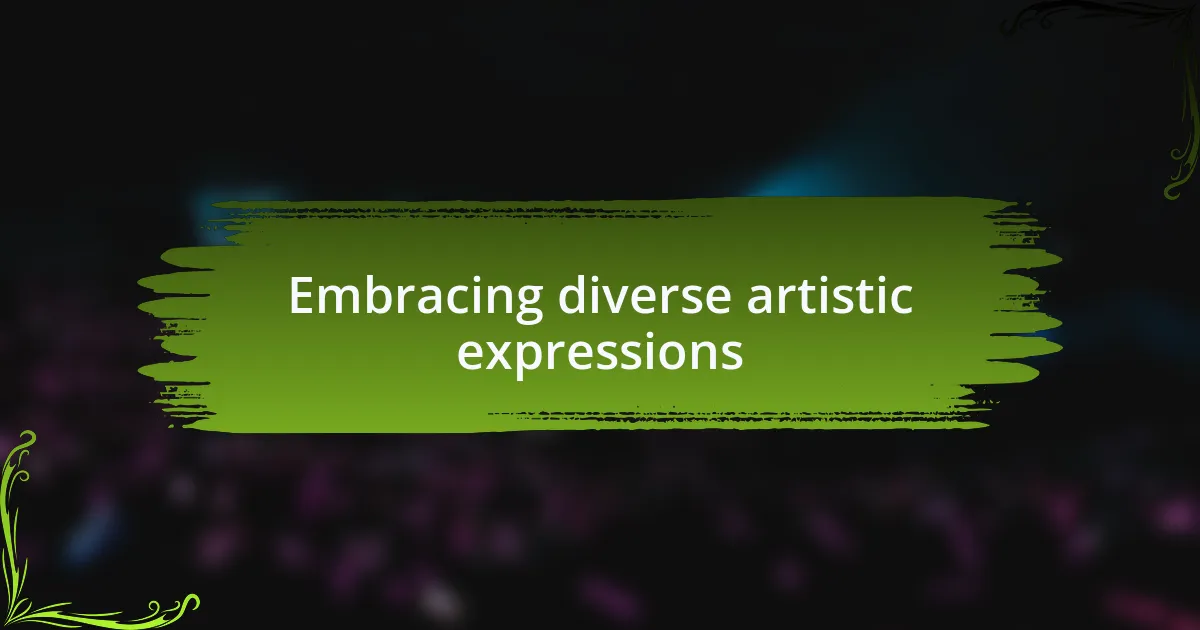
Embracing diverse artistic expressions
Embracing diverse artistic expressions requires an open mindset that appreciates the spectrum of creativity. I remember attending a music festival where I encountered genres I’d never heard before, from experimental electronic sounds to rich folk melodies. Each performance painted a unique picture of the artist’s culture and experiences, inviting me to see the world through their eyes. Isn’t it incredible how one festival can showcase such a wide array of perspectives?
I often think about how our preconceived notions about genres can limit our appreciation for artists. For instance, I once dismissed a hip-hop artist simply because they didn’t fit the conventional mold. However, when I finally took the time to listen, the depth of their lyrics and the storytelling within their rhythm completely shifted my view. This experience taught me the value of stepping out of my comfort zone to embrace what might initially seem unfamiliar.
The beauty of music lies in its ability to resonate with different emotions and stories. I often find that the most profound connections arise from artists who channel their unique backgrounds into their work. It strikes me that when we celebrate these diverse expressions, we not only enrich our own experiences but also contribute to an inclusive atmosphere where creativity can flourish. How might our own lives be transformed by seeking out and embracing this artistic variety?